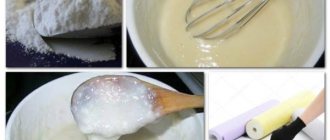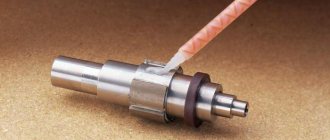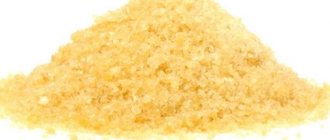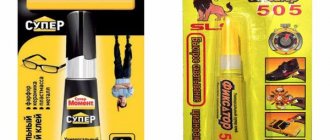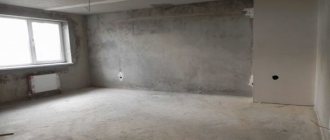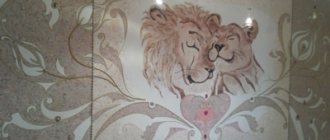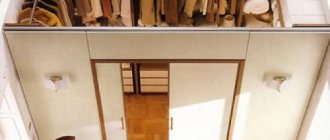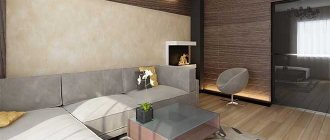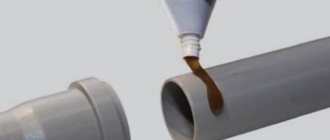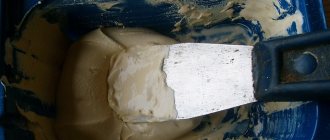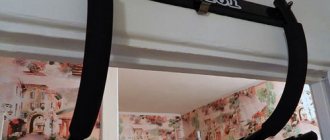What is thermally conductive adhesive and what is it used for?
When connecting parts that are exposed to high temperatures, for example, LEDs on radiators, many are faced with the problem of choosing an adhesive. Most species have a limited temperature range. Their adhesive properties deteriorate when heated, and the components included in the composition begin to evaporate. At best, an unpleasant odor emanates from the seam; at worst, the evaporation of toxic components negatively affects human health.
Heat-conducting glue is used to bond heated parts. It does not change its properties when heated and does not emit toxic fumes, which is why it can be used to connect parts that are subject to regular heating.
Another function of thermally conductive adhesive is heat dissipation. It contains particles that have higher thermal conductivity than air. The substance fills the space between two surfaces and provides heat removal. Usually this function is performed by thermal paste, but when it is necessary to fasten two elements, it is replaced with hot melt adhesive.
Thermal adhesive is sold in small tubes or tubes in liquid form. Before use, unscrew the cap and poke a hole in the protective membrane. Afterwards, the tube should be closed so that the substance does not dry out. Some brands, for example, AlSil, are sold in syringes, which makes application even more convenient - just squeeze a small amount of mass onto the surface.
In appearance, hot melt glue is a thick white mass of uniform consistency. It does not have a pronounced odor, in addition, when heated, the smell does not appear either.
The most popular brand of hot melt adhesive is Radial. In addition to thermal conductivity, it is resistant to ultraviolet radiation and high humidity. No oxidation occurs when applied to aluminum, silver or steel surfaces. Operating temperature range – from -60° to +300°.
Hot-melt adhesive is used to glue LEDs, processors, power transistors, microcircuits in switching power supplies, and in TV units with a kinescope to radiators. Areas of application:
- power electronics;
- Computer Engineering;
- temperature sensors.
Wood glue
Wood glue is usually used for working with wooden parts, although it does an excellent job of gluing paper, cardboard, textiles and some other types of materials. It should be noted that if you store it for a long time, a crust will form on the composition, mold may appear and yellowing may occur. It doesn't smell very nice. This type of glue has a thick consistency, it is thicker than many similar products. To glue the products, you need to cut off a piece of this mass and heat it to give it a liquid state. Heating is done over low heat. There are different recipes for creating the product, each using dry wood glue.
The first option is to complete the following steps:
- The purchased carpentry component is divided into small parts, immersed in water, in which it should swell.
- The resulting mixture is transferred to a container to be placed in a water bath, the mixture should heat up, while stirring regularly, making sure that the mixture does not burn.
- The thickened mixture is removed from the stove, alcohol is added. The ratio of the mixture to alcohol is 750/950 in grams.
- Powdered alum must be added to the resulting mass; the proportion of glue to alum is 100/12g.
The finished glue is distinguished by its moisture-repellent properties and high-strength connection.
Wood glue is usually used for working with wooden parts, although it does an excellent job of gluing paper, cardboard, textiles and some other types of materials.
It is possible to prepare wood glue a little differently:
- A kilogram of dry glue is placed in a container.
- A liter of water is poured into the particles.
- Wait for swelling, having received a mass similar to jellied meat, transfer the container to a water bath.
- Heat until a liquid mass is obtained, stirring all the time, burning is unacceptable.
- After removing the product from the heat, mix it with a liter of 9 percent vinegar, this completes the process, and you can use the cooled glue for its intended purpose.
The finished glue is distinguished by its moisture-repellent properties and high-strength connection.
The third option consists of the following:
- Dry glue in a ratio of 1/1 is combined with water.
- Add the same amount of glycerin.
- Place the components in a water bath and heat until all the liquid evaporates.
- The glue is ready for use.
It must be stored dry; for reuse, you need to add water in a small amount.
It must be stored dry; for reuse, you need to add water in a small amount.
Self-production
Conductive grease can not only be purchased ready-made, but also made with your own hands. However, before giving manufacturing instructions, it is necessary to answer a number of the most common questions among beginners:
- Is Moment glue capable of conducting electricity? No, none of the many variations of this adhesive are capable of conducting current.
- Is Superglue electrically conductive? To answer the question you need to understand the nature of conductivity. This type of substance does not contain components (metals, graphite) that conduct electricity. Thus, in terms of its capabilities, “Superglue” is almost identical to plastic.
- What about epoxy compounds? Epoxy resin does not transmit electricity for the reason stated above.
- Are high-voltage repairs using specialized glue allowed? No, such work is prohibited in accordance with safety regulations.
- I bought Kontaktol, but it does not give the desired effect. The reason is most likely that the product is counterfeit. The popularity of this brand has led to a large number of counterfeits.
- What is needed for the electrical conductivity of the composition? The adhesive must necessarily contain conductive components. Moreover, their specific gravity must be sufficient to ensure electrical conductivity.
Name Confusion: Circuit Adhesive
For people involved in circuit design, the words “thermal adhesive” have the same meaning as “hot-melt adhesive for radiators.” It is very difficult to make such a material with your own hands, since it uses chemical reactions, and not a change in the state of aggregation of the substance under the influence of temperature.
It is impossible to compare hot-melt adhesive for a gun and hot-melt adhesive for LEDs, which are different in composition and purpose. You can make the so-called glycerin cement with your own hands from lead litharge and glycerin as a heat-conducting layer and an adhesive at the same time.
There are also proven industrial options for heat-resistant materials for gluing, which, of course, are better to have in stock than to prepare hot-melt glue yourself. "Alsil-5" and "Radial" are the most well-known brands among specialists. In addition, several types of heat-conducting rubber are produced. You should read the instructions about how exactly heat-resistant glue is used.
How to Make Conductive Silver Based Adhesive
To avoid these problems when working with non-ferrous metals, you can make conductive cream on silver, but this is much more difficult than working with pencil lead. Before starting work, you need to acquire silver nitrate, but this may be more difficult than replacing it with nitric acid; it also conducts electricity.
At the pharmacy you need to buy a 1% formaldehyde solution and a bottle of ammonia (ammonia).
Having carefully measured equal proportions, you first need to mix formalin and silver nitrate, then add a couple of drops of ammonia to the resulting mixture.
Related article: Features of using covering film
If the actions were carried out without errors, after some time a black precipitate will form in the resulting composition - silver powder, which must be removed from the liquid (distilled water or a filter can be used) and used for electrical conductivity purposes. This is followed by drying of the sediment extracted from the liquid at a high temperature of 105-150 degrees Celsius. The resulting dried black powder must be added to any quick-drying glue similar to the previous recipe. Professionals advise first mixing the glue with a small amount of alcohol. Due to the high drying rate of the composition, it requires periodic stirring.
There are a huge number of similar recipes, but they are all based on the same processes. It is enough to remember the chemistry or physics lessons at school to identify which elements conduct current, and later, based on them, prepare the ideal adhesive paste for the product.
PVA glue at home
PVA consists of water and polyvinyl acetate, plasticizers are also added. PVA comes in different types, and accordingly it is used for different jobs; to impart certain properties, other components are added. It comes in white or beige. Can be used as a primer or wallpaper adhesive.
How to make PVA glue:
- Take photographic gelatin, five grams is enough, soak it and leave it like that for a day, you don’t need to pour a lot of water.
- After a day, distilled water (1 liter) is poured into a metal container and placed in a water bath.
- In a separate container, one hundred grams of wheat flour is diluted in water (the water should be cold), then the composition is added to the container with heating water.
- While mixing the ingredients together, add gelatin.
- Keep the container on the fire until it boils; it is important that the liquid should not boil.
- When the liquid solution begins to thicken (the consistency is similar to thick sour cream), you can remove it from the stove.
- Add four grams of glycerin and 20 milliliters of alcohol.
- Everything is thoroughly mixed; you can use homemade PVA when it has cooled down.
If the glue turns out to be too thick, you can dilute it with distilled water. The product is stored in a closed container for 6 months, subject to a temperature range of +10 to +15 degrees.
If the glue turns out to be too thick, you can dilute it with distilled water.
Famous brands
There are not many brands of conductive adhesive manufacturers on the market. Among them there are both Russian and foreign companies. Below we list the most proven brands of adhesives:
- Conductive adhesive grade Kontaktol on silver 2g is intended for creating highly elastic, durable surfaces. Produced on a silver base. It dries quickly, making it easy to use. You can purchase Kontaktol at any radio store or market. However, it should be noted that most reviews about this brand are negative.
- "Elekont" is a conductive composition based on epoxy resin, often used by car enthusiasts. Reviews about this product are also not always positive.
- Foreign-made “Done Deal” glue. “Done Deal” is highly durable and reliable. This brand has good reviews from professionals.
- Homakoll is a popular brand of conductive substance that has been on the market for a long time. Most often used as a conductive adhesive for linoleum by large manufacturers. Has antistatic properties.
- "Mastix" is an electrically conductive lubricant for repair work on the rear window of a car. Mastix is considered the best choice in its segment.
- TPK-E is a brand of glue from a Russian manufacturer. A special feature of the composition is the ability to maintain performance characteristics over a wide temperature range - from minus 190 to plus 200 degrees Celsius. Most often this brand is used in industrial settings.
How to mix tile adhesive correctly?
Only at first glance it seems that diluting the glue is as easy as shelling pears.
There are many nuances, failure to comply with which can not only make the glue unusable, but also completely ruin the cladding.
Rules and principles for diluting dry glue
Experienced builders recommend following these rules:
- the mixing container must be clean, the remnants of the previous glue or solution must be scraped off the walls, otherwise they will disturb the composition;
- the water must be clean and match the temperature of the dry mixture and the environment (it will need to be heated or cooled);
- the mixture must be poured into the liquid, and not vice versa, otherwise it will be more difficult to get rid of lumps;
- It is better not to use industrial water due to the presence of impurities that can react with the glue;
- if the cement mortar in the container begins to set, diluting with water will not help, it is better to prepare a new mixture;
- Do not exceed the permissible volume of water, otherwise the solution will turn out liquid and will not hold the tiles.
Advice! If there is any doubt about the consistency of the glue, the mixture should be left for 5-10 minutes. If the texture remains unsatisfactory, you can add a little water or dry powder.
How to mix tile adhesive: choosing a tool
If you have to prepare 10 or less liters of glue, it will be convenient to mix the components using a long rectangular trowel.
This steel spatula with a curved handle can be used by hand, trying to lift dry particles from the bottom so that there are no lumps.
Preparing large volumes of glue by hand is problematic. You will need a drill with a paddle attachment - only it should be designed for mixing the solution, not paint. Experienced craftsmen use a construction mixer with a whisk for this purpose.
The rotation speed of the nozzle should not exceed 300 rpm.
In this case, the blade must be completely immersed in the solution, otherwise bubbles will appear in the texture, deteriorating the quality of the glue.
Step-by-step dilution of glue
Work order:
- Pour water at the desired temperature into a clean, prepared container. According to the instructions, add the dry mixture to the liquid. To begin with, it is better to take ⅔ water, and if the mixture turns out thick, dilute it with the rest of the liquid to the optimal consistency.
- Measure out the required amount of dry mixture planned for the first batch.
- Add the first portion of dry glue, stirring the solution. Add the entire prepared mass in small doses, stirring to achieve a uniform consistency.
- Leave the solution for 10-15 minutes so that the particles are well hydrated.
- Stir again to break up any remaining lumps and separations. The glue is ready for use.
The mixture should be quite thick and elastic. It’s easy to check its quality - just scoop up the glue with a trowel and turn it over. A high-quality solution should not drain or fall off in pieces. During the process of laying tiles, it is recommended to stir the solution periodically so that it maintains its plasticity and does not dry out.
Advice! The longer the glue is mixed and whipped, the more liquid it turns out. The situation can be corrected by adding a small portion of the adhesive mixture.
Features and properties of conductive adhesives
The basis of such glue is the presence of certain constituent components that can provide the required level of electricity passage.
These include ordinary graphite, nickel powder, polymers, powdered silver - fine powder of any conductive metal will do. The adhesive mixture must be elastic and at the same time have a low resistivity. Elasticity will ensure precise application of glue and will not allow it to spread over the surface. In this matter, the main thing is to maintain the required ratio between powdered electrically conductive fillers and polymer binders. A large number of additives capable of conducting current can lead to a decrease in the quality of adhesion to various surfaces, which will affect the reliability and strength of contacts.
The next important feature for work will be the time required for the prepared mixture to dry. The faster the glue dries, the better and more convenient it is for the master to work. To do this, when making your own adhesive mixture, use any ready-made quick-drying glue or conductive varnish
Due to the fact that microcircuits heat up during operation, the glue must be heat-resistant and necessarily safe for the working master and others
To do this, when making your own adhesive mixture, use any ready-made quick-drying glue or conductive varnish. Due to the fact that microcircuits heat up during operation, the glue must be heat-resistant and necessarily safe for the working master and others.
Rubber glue
This glue is used to fix rubber objects. To make a durable option, you need to choose the right components.
It is often believed that filling car tires with gasoline is a suitable option for obtaining high-quality glue, but in reality this is not the case. You should choose raw rubber; it is advisable to use aviation gasoline.
Step-by-step cooking instructions include:
- The rubber is crushed and added to a glass jar.
- Pour gasoline, the rubber should cover the top.
- When the rubber has liquefied, gasoline is poured in again, in an amount sufficient to obtain a suitable consistency.
- Storage requires darkness and warmth.
You can replace raw rubber with rubber shoe soles, and the material must be TPR.
This glue is used to fix rubber objects.
Made by yourself
Many novice radio amateurs are wondering how to make conductive glue with their own hands. Here it is necessary to clarify some questions that beginners ask most often.
- Does glue conduct current? This is an adhesive that was developed and introduced by the German company Henkel. A total of 6 compounds were created for various purposes, but none of them conduct current.
- Does super glue conduct electricity? To answer this question, it is necessary to turn to the very concept of an electrically conductive material. Super glue does not contain components that would allow it to be called electrically conductive (graphite, metals), so its performance in this regard is practically no different from plastic.
- Does epoxy conduct electricity? Epoxy resin does not conduct electricity due to the above reason.
- Is it possible to repair high voltage wires using this glue? Masters do not recommend doing this, as it goes against safety rules when working with electricity.
- Why doesn't the contactor work? In modern times, a lot of fakes of this glue have appeared, so it is better to purchase this glue with guarantees from the manufacturer.
- What glue conducts electricity? Any adhesive that contains electrically conductive components in sufficient quantities.
Decoration with glue
Transparent or colored hot melt adhesive with your own hands can be turned not only into a fastening composition, but also into a decoration element. Simple and inconspicuous glass vases, treated on the outside with a hot-melt adhesive pattern, will sparkle with new colors and will impress your guests as an original work of your own.
In the same way, you can draw three-dimensional figures and entire pictures on any household containers, boxes, or simply on cardboard for a frame on the wall. Not any paint is suitable for coloring colorless glue - watercolor or gouache will quickly be erased from the surface. It is best to use acrylic-based paints or, as a last resort, nail polish.
DIY hot glue crafts are a great way to spend time with children, teaching them accuracy, responsibility and artistic flair. The main thing is not to leave children alone with the device turned on or just warmed up.
Qualities of electrically conductive paste
So how do you determine which glue is right for the job? A good conductive adhesive has the following qualities:
- High drying speed so that there are no pauses in work.
- High viscosity for ease of use and protection of parts of the electrical circuit that should not be exposed to glue.
- Large adhesion values.
- Heat resistance (when soldering).
- Safety for both the worker and the environment.
- Low electrical resistance, otherwise this glue will conduct current extremely poorly.
- Content of polymers in the composition.
- The glue must not be water based. Otherwise, the elements of the microcircuit may be filled with this glue and damaged, and the glue itself may take too long to dry, which will slow down the work of the master.
The glue is sold in construction or radio engineering stores at a relatively low price - only ±100 rubles for just 25 grams. Considering that the same PVC coatings require at least 250 grams of glue per square meter, and for textiles or metal even 400, the price of glue turns out to be quite high.
Of course, home-made conductive paste can be more profitable than its store-bought counterparts, but it has a very limited margin of safety. Moreover, none of us is immune from mistakes; It is possible that a mistake was made during the production of the glue, which could damage expensive equipment. If you are not completely confident in your abilities, then store-bought glue can also be a great option. For example, “Kontaktol”.
The composition of this glue is low-viscosity and resembles a paste and is made on the basis of epoxy, polyester and other synthetic resins, and silver, gold or palladium powders make it directly electrically conductive. It is not that expensive: 190 rubles. However, when buying it you should be careful: recently cases of sales of counterfeits have become more frequent, so it is better to contact the seller with guarantees.
Casein glue
Casein type of glue is used to glue paper, cardboard, leather products, as well as for wood. To obtain casein, the cottage cheese is defatted. For this:
- 2 tbsp. spoons of soda are diluted in a liter of water.
- Leave for twenty minutes.
- The cottage cheese is washed, it must then dry.
- The hardened mass is ground to obtain a powder.
This powder will be a component of the glue. Place 100 grams of casein on fire, slowly pour in water (200 ml). Constantly mix the components until a thick mass is obtained. You can work with cold glue. You should not prepare a lot of product at once, because the product can be stored for no more than 3 hours. The hardened product cannot be used. This is the most natural glue.
Casein type of glue is used to glue paper, cardboard, leather products, as well as for wood.
The article described how to make glue at home. These are simple recipes, the ingredients for which are easy to find. You can get cheap but reliable solutions for gluing all kinds of materials. The main thing is to strictly adhere to the recipe, then the connection will be strong and durable.
Choosing glue in the store
There is a wide variety of adhesive solutions on the market that have electrical conductivity. When choosing, you have to give preference to good conductivity or adhesive ability and rapid hardening. The best option is a substance recommended for use in the mechanical engineering field.
A large number of companies are involved in the production of conductive glue, and famous manufacturers do not always offer the best product. To find a suitable option, taking into account the purposes of further use, it is worth familiarizing yourself with the common varieties and taking into account their characteristics and physical properties.
"Kontaktol"
The adhesive produced under the Kontaktol brand is an innovative development of the German manufacturer Keller. The product is intended for mounting microcircuits, repairing tracks on printed circuit boards, and eliminating defects on contacts in electrical appliances. The substance sets quickly, and after 5-7 hours absolute polymerization occurs. To speed up the hardening process, it is allowed to warm up the treatment area with warm air.
Permatex
Permatex brand adhesive is a conductive two-component composition. The main purpose is to restore glass heating filaments. The advantage of this variety is its high resistance to temperature changes and the influence of ultraviolet radiation. The best results can be achieved when using Permatex at an ambient temperature of at least 10 degrees.
TPK-E
TPK-E adhesive is used for gluing aluminum products, stainless steel and carbon fiber together and in various combinations. Solution treatment helps ensure electrical connection with transient resistance. Thanks to its consistency and composition, the product removes static charges from the material.
Forbo 615 Eurostar Lino EL
Forbo conductive adhesive is practically odorless and has a translucent consistency. Most often, the substance is used for repair work, including fixing carpets, linoleum and other materials on the floor.
DoneDeal
DoneDeal glue from an American manufacturer has good adhesion to most materials. The product is water resistant and suitable for repairing water transport. If the rules of use are followed, the strength of the adhesive seam exceeds the strength of the material being processed.
Homakoll
Honakoll products are designed specifically for gluing rolled floor coverings on a fabric or pile base. The solution is characterized by the following properties:
- absence of volatile solvents in the composition;
- low water content;
- resistance to shrinkage after hardening;
- minimal risk of shearing and peeling after adhesion to the surface;
- easy application with a notched trowel;
- fire safety.
MASTIX
The Mastix brand substance, also known as cold welding, is superior to similar products in a number of respects. The composition can be used at extremely low and high temperatures without loss of original properties. Most often, Mastix glue is used to join metal products; it is also used to fill cracks and various holes. Under the Mastix brand, formulations for universal use and intended for use in specific areas are produced.
"VolgaKhimProm"
VolgaKhimProm conductive adhesive is used as a restoration and reinforcing composition. After application to the surface, the product hardens completely in 30-50 minutes, depending on the thickness of the layer. VolgaKhimProm products are suitable for use in domestic conditions and on an industrial scale. The composition does not have a negative effect on the skin, respiratory tract and mucous membrane, which makes it safe.
Making epoxy glue
Epoxy glue cannot be prepared from components that are always available at home; it requires epoxy resin and a hardener. To obtain this glue, these elements are mixed together in compliance with the proportions.
Epoxy is a transparent solution; on sale it is always found complete with a hardener. It serves as a catalyst for polymerization. After the start, you should have time to cover the surface of the products to be glued with the solution before the composition hardens.
The composition reliably and firmly holds objects together and can be used for gluing many materials. Popular applications in the following areas:
- In the shoe industry, for shoe repair;
- For gluing plexiglass, plastic, wood;
- For metal products;
- As a potting material;
- For gluing electrical devices.
Typically, 6-8 parts of resin are added to 4 parts of the hardener, but you should follow the manufacturer’s instructions on the packaging. Copes with the connection of glass, plastic, PVC, metal and other products, creating super strength.
Epoxy glue cannot be prepared from components that are always available at home; it requires epoxy resin and a hardener.
Recommendations for preparing and storing glue
To ensure that the glue retains its properties for as long as possible, follow our recommendations:
- Always store formulations in tightly sealed containers. If the container does not close tightly, use one layer of aluminum foil and two layers of polyethylene as a lid gasket.
- If you use the solution from a jar, do not pour it over the edge, as it will get onto the neck and the lid will stick tightly. For convenience, take a brush.
- Always label formulations and keep them away from children and heat sources.
- If the recipe contains solvents or gasoline, use a respirator and gloves.
- Do not use containers in which glue was prepared for storing food products.
- Before you start creating the glue, prepare and measure all the necessary materials in advance.
- Do not dilute the compositions with water; use drying oil or solvents for this.
We recommend watching the video instructions:
Boiler-based glue gun
Now we can be sure that the boiler will not burn without water, but will only heat up to the required temperature. The next step will be to make a comfortable handle so that you don’t get burned on the heated device. The most accessible material for a handle is wood, but it is also sensitive to high temperatures and you can use Teflon tape, used in cooking, to protect it.
As a working container for melting the glue, you need to make a tube and a funnel from a tin can, connecting them together so that the edges of the funnel cover the tube. The diameter of the working crucible should be such that the funnel is tightly clamped by the coils of the boiler. We additionally strengthen the structure with copper wire and test the device on a suitable piece of glue stick. This design compensates for the absence of a feed lever with incredible “omnivorousness”, that is, the tool is suitable for any type of hot-melt adhesive, regardless of its melting point.
What characteristics should a conductive adhesive have?
Manufacturers of ready-to-use compounds focus on the main function of conductive adhesive - high conductivity. Self-preparing glue allows you to achieve an ideal balance between the quality of electrical conductivity and reliability of adhesion
Moreover, depending on the task at hand, glue with different properties may be required, because in one case you need glue that maintains elasticity, in another the rigidity of the connection is important
Making your own glue allows you to achieve an ideal balance between the quality of electrical conductivity and the reliability of adhesion. Moreover, depending on the task at hand, glue with different properties may be required, because in one case you need glue that maintains elasticity, in another the rigidity of the connection is important.
In any case, the glue must have the following characteristics:
- high adhesion (adhesion) to different types of surfaces;
- low specific electrical resistance;
- sufficient viscosity;
- high covering ability;
- connection strength;
- high thermal stability (resistance to temperature changes);
- water resistance.
In a matter of minutes, you can make your own conductive adhesive that will meet the required characteristics.
Features of the composition of superglue
The molecular formula is the same for all cyanoacrylate adhesives: CH2 = C(CN)COOR. This is a liquid cyanoacrylate monomer, or cyanoacrylic acid ester. R is a radical, it can be ethyl, methyl, butyl and other monovalent radicals, depending on which the technical characteristics of the glue change. Any superglue contains up to 97-99% cyanoacrylate, as well as the following substances:
- plasticizers – give superglue elasticity;
- stabilizers - keep the glue quite liquid before application and provide the necessary properties after hardening;
- thickeners – provide the necessary thickness and consistency of the gel;
- modifiers - necessary to enhance the water resistance of superglue to the level of D3-D4, heat resistance (divinylbenzene, cyclopentadiene and others);
- adhesion enhancers – increase the adhesion strength of glue (PVA, polyacrylic);
- curing activators (needed when there is insufficient humidity) or curing inhibitors (to prevent spontaneous polymerization);
- fine metal powders - to improve the conduction of electricity.
Unlike other adhesives, superglues do not contain organic solvents. This makes them safer for humans and also suitable for gluing metal. On sale you can find different types of superglues, which are supplied in the form of blisters, tubes, jars, and adhesive tapes. They have a common feature: a small volume of packaging, because after opening it, even with a slight decrease in the tightness, the gel glue quickly becomes viscous and then completely deteriorates.
Features and Properties
The first electrically conductive compound was developed by Germany at the beginning of World War II. Initially it was used only in mechanical engineering. Over time it became universal. Now it is used as a solder when laying heated floors and heating systems, which is due to the ability of the adhesive solution to withstand high temperatures.
- It dries quickly, so gluing must be carried out without interruption.
- It has a high viscosity, which prevents the mixture from flowing into the boards.
- High adhesive characteristics ensure reliable adhesion to the surfaces being processed; it is well fixed on glass, plastic, etc.
- After drying, it can withstand temperatures up to +160 °C while maintaining its structure.
- Safe for humans and nature.
- The elasticity of the composition allows for spot application.
The conductive composition has low electrical resistance. Its use helps protect parts from damage, shock and vibration loads. Thanks to the conductor adhesive, the boards will not react to temperature changes.
Before use, you need to carefully study the composition of the glue and do not use products containing water. The composition and instructions for use are indicated on the original packaging of the glue. For microcircuits, wire contacts, cables, and other electrical elements, the water base is destructive. This composition will take a very long time to dry.
The current-carrying component in the adhesive is often graphite or nickel powder, silver or any other metal. The higher the content of the electrically conductive component, the worse the adhesion of the glue to the surface.
- you can repair computer cables and microcircuits;
- used when installing heating baseboards;
- used as linoleum adhesive when laying antistatic flooring;
- Defects in car electrical systems are eliminated, rear window heating is repaired;
- piezoelements are fastened in radio equipment;
- used when replacing the soldering of light-emitting diodes.
Work with conductive mixtures takes place indoors to minimize environmental pollution.
Benefits of using homemade adhesives
You can make wallpaper glue from whatever is in your kitchen cabinet or pantry. Homemade adhesive cannot be an alternative to a purchased product. Chemical companies produce various types of wallpaper glue with important technical features and improved composition. The purchased adhesive product contains substances that prevent the wallpaper from becoming damp in conditions of high humidity, prevents the development of mold and mildew, and has insecticidal properties.
Homemade glue does not have all these qualities. After all, it is prepared from simple substances, the main property of which is to form an adhesive substance during thermal, chemical treatment or when mixing various ingredients. True, homemade glue has its advantages. It is prepared from simple, often inexpensive ingredients. The finished composition, made at home in the kitchen, will be 10 times cheaper than purchased adhesives. A homemade adhesive is prepared from natural raw materials. This means that this glue can be used in any room, even in a children's room.
Types of Kontaktol glue
Electrically conductive adhesive Kontaktol is a product of the famous Keller concern (Germany). The manufacturer offers the following modifications:
- “on silver” – a one-component composition based on purified silver for creating electrically conductive tracks on textolite and other solid substrates;
- “Radio” glue is created with a graphite filler, so it is cheaper compared to the previous version;
- The adhesive marker is made of silver powder with PVC filler - this solution simplifies the handling of the restorative agent in difficult working conditions.
For your information. After hardening, Kontaktol electrically conductive glue creates a moisture-resistant “path”. Standard containers are 2, 5 and 10 g. Resistivity is 0.01 Ohm per cm3.
Tags: , beat, sconce, view, harm, choice, house, , sign, how, computer, , installation, voltage, wire, start, , work, rib, repair, recipe, row, garden, light, LED, connection , resistance, means, ten, current, transistor, filter, shield, electricity, effect
Price of ready mixes
Isn’t it easier to buy ready-made mixtures for liquid wallpaper? Let's calculate how much they will cost. Of course, it is impossible to talk about an approved price, since there is a distinction between the basics in the form of the composition of the material.
Depending on the silk fiber content, liquid wallpaper costs from 300 to 600 rubles per package (10% and 100%, respectively).
The material consumption per 1 m2 is also taken into account here. Based on the example given, the contents of the package will be enough for 8 or 3.5 m2, respectively. Now you need to calculate the area of all your surfaces and divide it by consumption. We get the number of packages, multiply by the cost of the selected mixture and we get a decent amount. Repairs are always expensive, you must admit, it will be nice to save on liquid wallpaper. Moreover, to realize that he made them himself.
The video below discusses this issue in more detail, and will also tell you about the wide range of mixtures.
Features of using thermally conductive glue
Hot-melt adhesives for LEDs and other parts that require thermal conductivity may differ in the method of use. It all depends on the components used for production. It may be necessary to coat the entire surface, or apply glue pointwise. In addition, the process is influenced by the form of release; there are ready-made solutions and dry mixtures.
The rules of operation also depend on the base itself, what material will be connected. When working with metals, apply the adhesive solution using a spot method. For this material it is convenient to use epoxy solutions, which are supplemented with plasticizers and additives.
For ceramic objects, it is advisable to use adhesives with cement and sand; they help create a good plastic coating. Glass requires the use of options with a base of organic elements. They help maintain transparency without disturbing the appearance of the processed parts.
The gluing technology, which is common to different products, includes the following steps:
Bonding the heatsink to the chip
Hot melt adhesive for microcircuit heat sinks is often used. The principle of operation does not differ much from that described above. The parts are degreased, the necessary areas are lubricated with glue, the processor is pressed against the microcircuit, and a suitable weight should be placed on top to ensure a tight connection. The glue usually dries in a few hours, but experts advise not to rush and wait 24 hours so that the setting is completely completed and the parts do not separate prematurely.
How to repair a chip on a windshield with your own hands
Chip on the windshield? Do you want to replace glass? Do not hurry! Try Windshield Repair Kit (WRK) and your windshield will last for a long time.
WRK composition:
- tube of special glue – 1 pc.;
- discs with 2-sided tape – 2 pcs.;
- syringe for creating a vacuum – 1 pc.;
- nozzle for supplying glue – 1 pc.;
- knife for scraping tape – 1 pc.;
- polyethylene plates – 2 pcs.
It is advisable to carry out the work in warm and sunny weather.
Condition of the windshield before repair:
Operating procedure:
1) use a thin steel needle to clean the chip from any remaining glass in it, dirt and other debris;
2) use a brush (or an old toothbrush) to sweep away all the remains;
3) we carry out the procedure for degreasing the chip and around it;
4) take one of the disks, remove the tape from one side and attach this side to the windshield, align the hole in the disk with the center of the chip, press the disk and iron it with force over the entire surface;
- 5) remove the tape from the outside of the disk and then tightly install the nozzle for pouring glue into the chip;
- 6) slowly pour glue until it fills the entire chip and 3/4 of the height of the nipple of the nozzle;
7) screw the syringe to the nipple and create a vacuum by lifting the rod and fixing it in the upper position. This removes any remaining air. Repeat the procedure several times within 10 minutes;
9) after another 20 minutes, everything is removed and the nozzle and disk are removed using a knife;
10) if there are any errors, then fill them with glue and put a plastic plate on top and iron them tightly. After 10 minutes, remove the plate, scrape off the remaining glue and be satisfied with the result.
Condition of the windshield after repair:
Have a nice trip!
Glue for gold leaf
Potal is used in gilding or silvering ceramic, metal, wood or glass parts. It represents an alloy with particles of precious metals, rolled into a thin sheet. Store-bought mixtures for gold leaf contain alcohol, oil, acrylic and water.
Recipe:
- 0.1 liter of heavy cream is mixed with the same volume of cognac;
- the mixture is applied to the treated base;
- After half an hour you can start gilding.
Recipe No. 2:
- 70 g of sugar dissolves in 0.2 liters of warm water;
- the syrup is placed on the stove;
- after the syrup boils, 1 teaspoon of acetic acid is added to it;
- in 30 min. the composition is removed from the stove and a third of a glass of starch is added to it;
- the mixture is stirred until the consistency of sour cream;
- After cooling, the product can be used to glue gold leaf.
Rubber glue
There are surfaces and objects that are constantly exposed to acids. If they break, it is necessary to use rubber glue, which is not afraid of the effects of such substances. It is prepared from a mixture of rubber, coal tar and asphalt with the addition of alcohol, ether and chloroform in equal proportions. It provides reliable fastening and is not affected by acids.
Advice! If you prepare this glue in a more liquid state, it can be used as an alternative to varnish for polishing wooden surfaces.
Materials for production
Radiators for cooling LEDs vary in design and material.
Ambient air can receive no more than 5-10 W from a single surface
When choosing a material for the manufacture of a radiator, the following condition should be taken into account: its thermal conductivity must be at least 5-10 W. Materials with a smaller parameter will not be able to transfer all the heat that air can absorb
Radiators are traditionally made from aluminum, copper or ceramics. Recently, products made from heat-dissipating plastics have appeared.
We also recommend that you read in more detail about your DIY switching power supply.
Aluminum
The main disadvantage of an aluminum radiator is its multi-layer design. This inevitably leads to the emergence of transient thermal resistances, which must be overcome by using additional heat-conducting materials:
- adhesives;
- insulating plates;
- materials filling air gaps, etc.
Aluminum heatsinks for 1 W LEDs
Copper
Copper has greater thermal conductivity than aluminum, so in some cases its use for the manufacture of radiators is justified. In general, this material is inferior to aluminum in terms of lightness of construction and manufacturability (copper is a less malleable metal).
It is impossible to manufacture a copper radiator using the pressing method, which is the most economical method. And cutting processing produces a large percentage of waste of expensive material.
Copper radiators
Ceramic
One of the most successful options for a heat sink is a ceramic substrate, onto which current-carrying routes are pre-applied. The LEDs are soldered directly to them. This design allows you to remove twice as much heat compared to metal radiators.
Light bulb with ceramic radiator
Heat dissipating plastics
Increasingly, information appears about the prospects of replacing metal and ceramics with heat-dissipating plastic. The interest in this material is understandable: plastic costs much less than aluminum, and its manufacturability is much higher. However, the thermal conductivity of ordinary plastic does not exceed 0.1-0.2 W/m.K. It is possible to achieve acceptable thermal conductivity of plastic through the use of various fillers.
When replacing an aluminum radiator with a plastic one (of equal size), the temperature in the temperature supply zone increases by only 4-5%. Considering that the thermal conductivity of heat-dissipating plastic is much less than aluminum (8 W/m.K versus 220-180 W/m.K), we can conclude: the plastic material is quite competitive.
Light bulb with thermoplastic radiator
Table - Comparison of thermal conductivity of various materials
| Material | Thermal conductivity, W/m.K |
| Aluminum | 120-240 |
| Copper | 401 |
| Ceramics | 15-40; 100-200 |
| Heat dissipative plastics | 1 – 40 |
| Thermal paste | 0,1 – 10 |
Review of popular brands
When choosing a suitable thermal conductive solution, it is recommended to familiarize yourself with the most popular brands. Products from top manufacturers are valued for their high quality and strong connection of components.
Manufacturers produce several types of thermally conductive adhesives under different brands, including natural and synthetic ones. The latter additionally contain plasticizers, which makes them resistant to moisture and frost. Both types of solutions are used for installation work with metal, ceramic and glass products. The difference between natural and synthetic solutions is the quality of the composition and the final cost.
"Radial"
Radial brand adhesive solution is suitable for mounting LEDs and heat dissipation fittings to transistors and processors in situations where it is not possible to apply thermal conductive paste.
When applied, Radial glue provides stable and high-quality heat removal without losing its characteristics at a temperature range from -60 to +300 degrees. A distinctive feature of the products of this brand is their slow drying, which allows them to retain their plasticity for a long time after being squeezed out of the tube.
"AlSil"
Hot-melt adhesive "AlSil" is a modern composition for screwless installation of radiators, cooling systems and other structures where heat removal is required. Glue is often used on memory boards in laptops and system units.
The composition is supplied in a syringe weighing about 3 g, which makes it convenient to apply to a work surface. The AlSil solution is economical in consumption, since it can be applied in a thin layer from a syringe.
GD9980
Thermally conductive composition GD9980 is used to displace accumulated air between the surface of the chip and the base of the radiator. The heat dissipation property of this brand of glue is less compared to products from other manufacturers, but the GD9980 composition is capable of particularly firmly fixing parts on the processor, attaching radiators to motherboards, RAM slots and video card chips.
Foam glue
Currently, foam and polystyrene plates are often used for insulation and soundproofing of residential premises. They are glued to the load-bearing wall. When choosing glue for polystyrene foam, you must take into account that solvents, such as acetone, can melt it. Therefore, the ideal option for it is the above-mentioned wood glue.
But, at home you can make another waterproof glue for polystyrene foam - from cottage cheese:
- To do this, mix lime (slaked) with cottage cheese in equal proportions until a homogeneous mass is obtained. It is advisable to use this glue immediately after preparation, as it hardens quickly.
Thermally conductive glue
Thermally conductive adhesive solutions can withstand frequent changes in temperature. Externally, it is a white substance with a uniform consistency.
Glue differs from thermal paste; it is used for small parts, in hard-to-reach places when applying thermal paste is impossible.
For the convenience of applying hot-melt adhesive to containers, a special sharp spout is made; with its help it is easy to treat small areas, evenly distributing the substance over the surface.
Scope of application and features
Hot-melt adhesive for radiators, processors, LEDs, microcircuits can be used. The adhesive works in such a way that it provides heat dissipation properties, which helps prevent overheating of the elements when making a connection. It is also not allowed to deform small parts when performing repair work using this method. An important feature is the absence of toxic components in the composition; you can work without fear for your health; the compositions are suitable for independent work at home.
Thermally conductive compositions have uniform technical characteristics, the following points stand out:
Adhesives are sold on sale in ready-made form, so that the glue retains its properties longer; a screw-on cap is made; the main thing is not to forget to close it tightly, then the composition will not harden longer.
Sandara glue
This type of glue is prepared according to this recipe:
- Alcohol, sandarac and turpentine in a ratio of 100:6:6 are mixed in a container
- The mixture is heated.
- Then add carpentry and fish glue in equal proportions, which were previously dissolved in hot water.
Note! Their quantity should be such that the finished glue is liquid but viscous. If the adhesive solution is prepared using this method, then the seams of the items will be moisture resistant after drying.
Drewpatch68 › Blog › An unusual recipe for conductive glue with almost zero resistance!
I’m posting the work of one dude for your honest judgement! I want to prepare this glue and try it myself - to restore 2 heating tracks. Let's go, I don't change the text and publish it on his behalf. At first I had hopes of making glue in the traditional way - from the lead of a soft pencil, from brushes from an electric motor, from the central contact of a salt battery. But every time I was disappointed - when drying, the resistance of the glue was, at best, in the hundreds of Ohms. For one button this might have passed, but when an entire field of keys had multiple damages, the result was not difficult to guess.
I googled it like any experienced radio amateur. Yes, silver-based recipes are available on many sites. But the trouble is that I don’t have the necessary chemical components and it’s almost impossible to get them in Lugansk now.
I started thinking about what to replace the silver with. And then it dawned on me: after all, ordinary copper is not much worse than silver. It is present in many parts and its resistance is not much greater than the resistance of silver!
Mastic glue
Most types of glue that are used to join porcelain, glass and earthenware have an opaque consistency, and after drying they leave unattractive yellow marks at the joints. Mastic glue is an excellent alternative that is colorless and completely transparent.
You need to prepare it according to this method:
- Make or find a suitable container with an airtight lid.
- Mix 55 g of chloroform and 68 g of crushed rubber in it.
- After the last substance has dissolved, add 10 g of granular or drip mastic.
- Leave for a week or 8 days in a closed container.
- During this period, the mastic will completely dissolve, and the glue will be ready for use.
Important! The finished glue will ensure reliable adhesion of earthenware, porcelain, and glass without unattractive traces of glue at the joints.
Waterproof glue
To prepare waterproof glue, you can use products from the refrigerator such as cottage cheese or milk that has just curdled. You need to add slaked lime to them. This will allow you to get a thick, uniform mixture. The resulting mixture can be used to glue wooden bases efficiently and reliably. They need to be pressed tightly together and dried well.
For another recipe for creating waterproof glue, you need to prepare ingredients such as wood glue, water, and drying oil. It is necessary to boil wood glue mixed with water and 35 g of drying oil in a prepared container. The prepared adhesive solution is applied in a heated state on a wooden surface. After hardening, the seams are not afraid of exposure to either cold or hot liquids and are completely waterproof.
Glue color classification
Let's take a look at these colored sticks. It can't be that manufacturers are just adding colorings at random. Indeed, there is a recommended international marking and here are the main types of cores for a heat gun:
Simple translucent cylindrical sticks are the most popular type of glue. Universal, used for a wide variety of surfaces and materials, suitable for almost any hidden and open fastenings. Colored opaque rods differ from universal ones only in color. It makes sense to buy them for those who do crafts, children and florists. They allow you to disguise the gluing area to match the overall color of the product without the use of additional coloring. Black and gray stickers are intended for waterproofing areas, and are also used as electrical insulation
The non-shrinking and adhesive properties of the material are used in sealing window frames and insulating current-carrying parts of electrical appliances. White opaque rods are used specifically for gluing metal and glass, except, of course, for universal adhesives painted white, pay attention to the packaging. Yellow or candle-colored, wood-colored translucent sticks have better adhesion to the porous structure of wood or cardboard
In any case, not all manufacturers have yet come to common standards and it is necessary to check the technical properties of the glue by checking the packaging. There you can also find out the melting point of the material and the approximate temperature range of its use.
In electrical appliances, materials that can withstand prolonged heating are often required; in other cases, a non-rigid plastic fixation, such as silicone, may be required, for example, in the manufacture of hand tools. You also need to take into account the capabilities of your device for working with glue, so that the heat gun has enough power to melt the material during operation.
Scope of application and features
This is a special material that is used for gluing LEDs, radiators, and microcircuits. In appearance, the glue is a white mass with a uniform consistency. This adhesive composition should be distinguished from thermal paste: it is used where the design of the product does not allow the use of paste or mechanical fastening. The product is sold in tubes with a thin spout, it is very convenient to use.
The principle of operation of the glue is that it removes excess air between the surfaces being fastened. After gluing, a heat-dissipating effect is ensured; overheating of parts during installation will be prevented. Deformation of elements due to overheating will also not occur. A distinctive feature is the safety of the material; it does not contain toxic components. Even when heated, it does not emit poisons and can be widely used at home.
Starch glue
To prepare such an adhesive solution, you need to take 10 parts of wheat starch, add cold water, stir thoroughly until thick, add boiling water, stirring constantly. The amount of hot water should be determined by the future desired consistency of the paste. To make it more durable, one part of alum should be added when warm. To increase stickiness, add 5-10 parts of wheat or 15-20 parts of rye flour.
